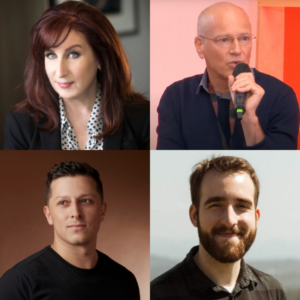Journalists who want to best inform the public about the vaccines and combat disinformation surrounding them can now take “Covering the COVID-19 vaccine: What journalists need to know” for free, online and at their own pace.
The course was first offered to journalists around the world as an instructor-led Massive Open Online Course (MOOC) from March 29 to April 25, 2021 and is now available as a self-directed course in English, French, Portuguese and Spanish.
The MOOC had widespread reach, attracting 4,325 students from 160 countries.
Now, students who took the MOOC can review materials and new students can learn from the course at any time from anywhere in the world, in a self-directed version from the same training program.

Course instructors CW from top L: Maryn McKenna, Yves Sciama, Andre Biernath and Federico Kukso
“It was really a thrill to experience how engaged the students in this course were, both with the material and with each other,” said lead instructor Maryn McKenna, a health and science journalist, as well as senior fellow at the Center for the Study of Human Health at Emory University.
“It’s always encouraging to hear that the interviews and readings are resonating; it confirms that we picked the correct experts to talk to and chose stories and background materials that were pitched at the level participants needed,” said McKenna, who was joined by three assistant instructors. André Biernath, a science journalist for BBC Brazil, was the assistant instructor in Portuguese; Federico Kukso, a science journalist and author from Argentina, was the assistant instructor in Spanish; and Yves Sciama, a science journalist from France and vice president of the French Association of Science Journalists, was the assistant instructor in French.
The MOOC was held in partnership with UNESCO, the United Nations Development Programme (UNDP), and the World Health Organization, and co-funded by the European Union. These entities also helped make the self-directed versions possible.
“The impact of this MOOC to me as a journalist is so huge,” one student said in final course evaluations. “And I firmly believe that all other journalists from around the world who enrolled in this course learned enormously through the videos, readings, and the live interactions via our forum and social media platforms.”
“We got a clear picture of the global situation, whether it is vaccine logistics, issues of vaccine availability, the politics of unequal distribution, spreading of new variants, issues of disinformation and the way ahead,” wrote another.
All self-directed versions of the course include four modules: 1) Vaccines are here: Now what? 2) When will vaccines arrive? 3) How can we trust the vaccines? 4) After vaccination, what is the future?.
A fifth module, which focuses on stories and issues related to the vaccine in Latin America, is available in Portuguese and Spanish.
Each module of the self-directed courses contains video classes, complemented by video interviews with guest speakers, readings and exercises that students complete at their own pace.
Guest speakers include coronavirologist Angela Rasmussen; the World Health Organization’s Kate O’Brien; Deepak Kapur, chairman of the Rotary International’s India National PolioPlus Committee; and Jessica Malaty Rivera, science communication lead for the COVID Tracking Project at The Atlantic.
More than one year into the pandemic, different parts of the world are opening while others experience new waves of contagion. For this reason, journalists need to remain attentive to covering COVID-19 and the vaccines.
“It’s a difficult thing to face, because we’ve all been at this so long now — 17 months, for those of us who started covering it right at the beginning — but COVIDis going to continue to be an important story for quite some time,” McKenna said. “Much of the world is still not vaccinated, so the race right now is between the pace of vaccination and the speed of evolution. I expect there are going to be plenty of surprises and many new things still to learn.”
A webinar for journalists covering the COVID-19 vaccines was held prior to the MOOC on Jan. 29. 2021. “Covering the COVID-19 vaccine: What journalists need to know” is available to watch in Arabic, Chinese, English, French, Hindi, Portuguese, Russian, and Spanish. The event was held in collaboration with UNESCO and the WHO, with funding from the European Union.
And, this is not the only self-directed course available for those who want to learn more about covering the global COVID-19 pandemic. Self-directed versions of the course “Journalism in a pandemic: Covering COVID-19 now and in the future” are available in Arabic, English, French, Portuguese, Russian, and Spanish.
UNESCO and WHO also helped the Knight Center compile a robust multilingual resource page for journalists who are covering the vaccines.
Take advantage of the self-directed courses, webinars and resource pages to ensure you’re prepared to cover the wide range of topics associated with the biggest story of our lifetime.